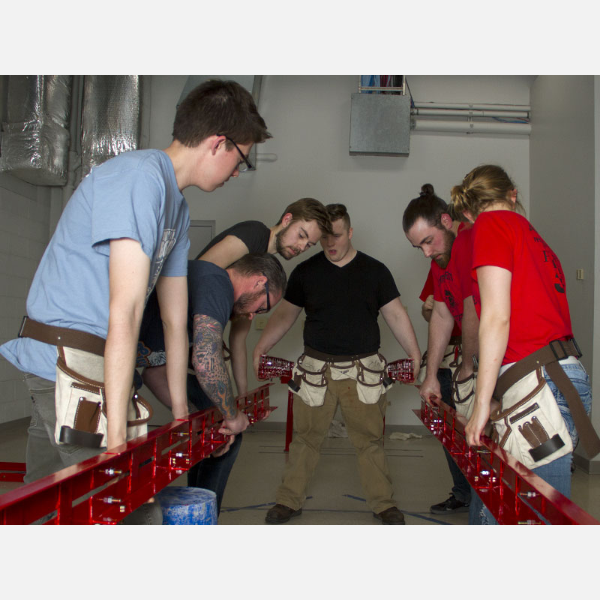Building Bridges
By Matt Hawkins
Bradley civil engineering students cringed as their steel bridge creaked, cracked and gave way under 1,200 pounds of weight, but they deemed their construction project a success. After all, only five teams in the American Society of Civil Engineers Great Lakes Student Conference steel bridge competition survived through the weight-bearing final.
By making the final test, Bradley’s team topped teams from 14 other universities and advanced to the competition’s decisive round. This marked the second consecutive year Bradley’s bridge made it to the finale.
“The bridge felt good as we were building it, so we didn’t think it would fail until it unfortunately did,” said team chair Karl Borling ’16, of Bloomington, Illinois. “It’s quite an accomplishment to get to that point because we realized how often bridges fail to pass tests at various stages of the competition.”
Bridges had to meet a long list of technical requirements and be quickly assembled without students breaking another set of rules before the 20 feet-long spans could be tested for strength. Bridges were judged by weight and assembly time, in addition to the ability to bear weight up to 2,400 pounds.
Bradley’s bridge checked in at 300 pounds, 40 pieces of steel no longer than 3 feet and numerous bolts — none of which could fall from the structure without incurring a team penalty.
Students assembled the bridge in 25 minutes while dodging another obstacle — a 6-feet wide “river” they weren’t allowed to step in while constructing the span.
“This experience was unlike any class or extracurricular activity at Bradley,” said team member Andrew Thompson ‘16, of Elgin, Illinois. “ASCE competitions are the best place to work through something on paper, enter it into design software and end up with a tangible product at the end.”
The team of eight began bridgework early in the fall semester. They brainstormed ideas and drafted the design in AutoCAD 3D. That design was loaded into another program, STAAD Pro, for a strength analysis test. A redesign midway through the process created challenges, but plans were submitted to a local fabrication company in plenty of time to work through last-minute details.
By April’s competition weekend, team members gained a set of tools they realized would help them in professional settings. They taught themselves new software, learned professional design nomenclature, mastered assembly tools and strengthened teamwork skills.
Kyle Smith ’19, of Alsip, Illinois, valued the opportunity to participate as a freshman. He was named the 2017 steel bridge team chair midway through the experience.
“It was rewarding to receive hands-on experience early in my college experience,” he said. “I knew I needed to learn a lot before I enter the field, and this pushed me a big step forward. Next year will be a good chance to apply what I learned this year and grow even more.”
Teammates took pride in their accomplishment as an extracurricular activity knowing many competing schools included the steel bridge competition as a senior design class project.
“It’s gratifying that we did it on our own without much faculty involvement,” Borling said. “We improved together as a team and accomplished a lot as we figured things out on our own.
Rebecca Neuman assembles part of the Bradley ASCE team's steel bridge. (Photo by Matt Hawkins)




